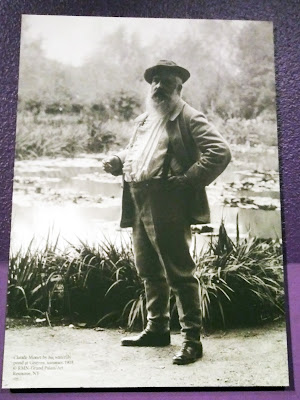A couple of firsts for me: first time to go to Denver Art Museum, a "world-class museum," and my first time seeing a collection of world-famous paintings by Claude Monet (#MonetatDAM). Having said that, I've set my expectations really very high, but also kept my emotions in check to balance my grip on reality.
My favorite Monet quote from the exhibit at the Denver Art Museum, just because it's DELICIOUS.
We showed our tickets, got in while the volunteers gave us some audio set for the infos. Once inside, everyone was like gasping in awe, murmuring everything positive. I was like, uhm ohkay, what am I missing?
That's him, Claude Monet himself by his lily ponds.
Sunset at Lavacourt 1880 detail
What I'm curious about the exhibit, Claude Monet: The Truth of Nature, is how the brilliance of colors were preserved. I wonder if Monet's pigments were as bright as they originally were vs now that I've seen them in person, or were they enhanced by the conservators. The paintings looked as if freshly painted, no hints of oxidation or dulling, especially in the oranges of the sun above, and most of the pinks and blues. The whites also have this shimmering quality to it, close to pearlescent effect, or it must be the varnish that gives the paintings their unique brilliance. Perhaps mixing colors while preserving brilliance is Monet's genius, and the merit of the Impressionists.
I'd like to quote Leonardo da Vinci's observation on colors that seem to explain the brilliance of colors, as edited by Martin Kemp in his book, Leonardo on Painting: "...I remind myself that pink will also be increased in beauty when the sun which illuminates it turns reddish in the west, together with the clouds that intervene, although in this case it may be accepted as true that a pink illuminated by a rosy light displays beauty more here than elsewhere, which indicates that lights of other colours than red will take away its natural beauty ..."
My favorite painting from Monet's exhibit at the Denver Museum, because at first glance, you won't notice there's something going on in the fields.
The Meadow at Vetheuil 1879
You'll be delighted to discover those details later.
There's a story somewhere.
Another favorite because the geese are so happy. The Geese 1874
Water-lilies and Japanese Bridge 1899
These Monet paintings (up and below) are, I believe, the two most popular as I've seen them used everywhere especially in art books. I was so eager to see these first because they're the lit paintings. I was anticipating these paintings fill the entire room, engulfing the viewer. I was expecting them to be as spectacular as Juan Luna's The Spoliarium. These pieces were placed near the end of the exhibit. Quite disappointed actually when I saw them finally, because they were not so big as I expected them to be!
I found the exhibit very hyped up, as expected for many celebrated works. I also found the staging quite dated and too dark (I understand the drama they're evoking but it was so dark) for such a world-class level of a museum and body of works. How I would have made the staging better: added more play of lighting, simulating the gardens, the paintings as if they're windows of the outdoors; added interactivity and participation not just the usual multimedia. Plus, I would also consider children guest's eye level, not just in the audio narratives.
Maybe I was preempted by this more interesting exhibit next door:
Treasures of British Art: The Berger Collection
This exhibit is more fabulous because, FASHION!
Mr. Berger really knows how to collect the jewels.
Portrait of a Lady, early 1600s, by "Follower of William Larkin"
Three Young Girls, early 1600s, by a British artist. (of course!)
Detail of Elizabeth Poulett painting, 1616, by "Follower of Robert Peake"
Detail of Portrait of a Young Lady, about 1620, by Paul van Somer
The beauty is all in the details and probably in their back stories.













No comments:
Post a Comment